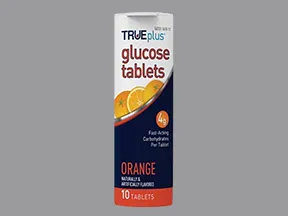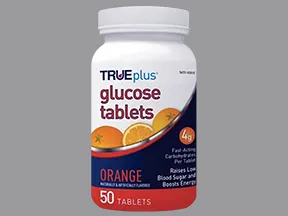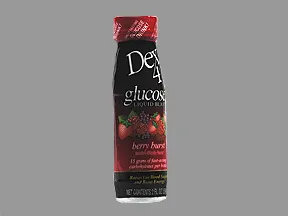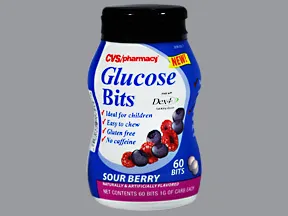D50W, DGlucose (dextrose) dosing, indications, interactions, adverse effects, and more (original) (raw)
Dosing & Uses
AdultPediatric
Dosage Forms & Strengths
intravenous solution
- 2.5%
- 5%
- 10%
- 20%
- 30%
- 50%
- 70%
oral liquid
- 55%
Hypoglycemia
IV: 10-25 g (ie, 20-50 mL 50% solution or 40-100 mL of 25%)
PO: 4-20 g as a single dose; may repeat after 15 min if self-montoring of blood glucose shows continued hypoglycemia
Dosage Forms & Strengths
intravenous solution
- 2.5%
- 5%
- 10%
- 20%
- 30%
- 50%
- 70%
oral liquid
- 55%
Hypoglycemia
Dilute before IV administration, may give more concentrated solution peripherally in emergency (ie, 12.5-25%)
< 6 months
- 0.25-0.5 g/kg/dose (1-2 mL/kg/dose of 25% solution) IV; not to exceed 25 g/dose
Infants > 6 months and Children
- 0.5-1 g/kg up to 25 g (2-4 mL/kg/dose of 25% solution) IV; not to exceed 25 g/dose
Adolescents
- IV: 10-25 g (ie, 20-50 mL 50% solution or 40-100 mL of 25%)
- PO: 4-20 g as a single dose; may repeat after 15 min if self-montoring of blood glucose shows continued hypoglycemia
Interactions
Interaction Checker
Enter a drug name to check for any interactions. + dextrose

No Interactions Found
Interactions Found
Contraindicated
Serious
Significant - Monitor Closely
Minor
All Interactions Sort By:

Contraindicated (0)
Serious (0)
Monitor Closely (0)
Minor (5)
magnesium chloride
dextrose decreases levels of magnesium chloride by increasing renal clearance. Minor/Significance Unknown.magnesium citrate
dextrose decreases levels of magnesium citrate by increasing renal clearance. Minor/Significance Unknown.magnesium hydroxide
dextrose decreases levels of magnesium hydroxide by increasing renal clearance. Minor/Significance Unknown.magnesium oxide
dextrose decreases levels of magnesium oxide by increasing renal clearance. Minor/Significance Unknown.magnesium sulfate
dextrose decreases levels of magnesium sulfate by increasing renal clearance. Minor/Significance Unknown.magnesium chloride
Minor (1)dextrose decreases levels of magnesium chloride by increasing renal clearance. Minor/Significance Unknown.magnesium citrate
Minor (1)dextrose decreases levels of magnesium citrate by increasing renal clearance. Minor/Significance Unknown.magnesium hydroxide
Minor (1)dextrose decreases levels of magnesium hydroxide by increasing renal clearance. Minor/Significance Unknown.magnesium oxide
Minor (1)dextrose decreases levels of magnesium oxide by increasing renal clearance. Minor/Significance Unknown.magnesium sulfate
Minor (1)dextrose decreases levels of magnesium sulfate by increasing renal clearance. Minor/Significance Unknown.
Adverse Effects
Frequency Not Defined
Hyperosmolarity
Edema
Venous thrombosis
Tachypnea
Fever
Hypermolar syndrome
Hypervolemia
Phlebitis
Diarrhea
Polydipsia
Pulmonary edema
Cerebral hemorrhage
Mental confusion, unconsciousness
Cerebral ischemia
Hypophosphatemia
Hypomagnesemia
Hyperglycemia
Injection site extravasation
Tissue necrosis
Warnings
Contraindications
Documented hypersensitivity; severe dehydration
Cautions
Use caution in DM or carbohydrate intolerance
Give 5% or 10% dextrose to avoid reactive hypoglycemia when highly concentrated dextrose infusion is abruptly withdrawn
An unexpected rise in blood glucose level in a stable patient may be an early symptom of infection; monitor for signs and symptoms of infection and laboratory parameters
Significant hypokalemia may occur from administration of potassium free IV dextrose solutions
Significant hyponatermia or water intoxication may occur from low sodium or sodium-free IV dextrose solution
Use caution in patients with diabetes mellitus; reduce the rate of infusion to reduce the possibilities of causing hyperglycemia and glycosuria
Increased serum osmolality and possible intracerebral hemorrhage may occur from rapid or excessive dextrose administration
Rebound hypoglycemia may occur following abrupt withdrawal
Hypertonic solutions (>10%) may cause thrombosis when infused through peripheral veins; best to infuse through a central venous catherer
Monitor changes in fluid balance, electrolyte concentrations, and acid-base balance during prolonged use
Caution advised, to avoid air embolism, when infusing medication
Monitor glucose levels and for possible hyperglycemia when treating pediatric patients
Dextrose injection contains aluminum that may be toxic; patients with impaired renal function, and preterm infants, at higher risk;. limit aluminum to <4 mcg/kg/day
Parenteral nutrition associated with liver disease; increased risk in patients who receive parenteral nutrition for extended periods of time, especially preterm infants; monitor liver function tests, if abnormalities occur consider discontinuation or dosage reduction
Monitor blood glucose and administer insulin as needed
Pregnancy & Lactation
Pregnancy Category: C/A (oral)
Maternal and fetal hyperglycemia may occur during labor and delivery; monitor
Lactation: Excretion in milk unknown; use with caution
Pregnancy Categories
A: Generally acceptable. Controlled studies in pregnant women show no evidence of fetal risk.
B: May be acceptable. Either animal studies show no risk but human studies not available or animal studies showed minor risks and human studies done and showed no risk.
C: Use with caution if benefits outweigh risks. Animal studies show risk and human studies not available or neither animal nor human studies done.
D: Use in LIFE-THREATENING emergencies when no safer drug available. Positive evidence of human fetal risk.
X: Do not use in pregnancy. Risks involved outweigh potential benefits. Safer alternatives exist.
NA: Information not available.
Pharmacology
Mechanism of Action
Parenteral dextrose is oxidized to carbon dioxide and water, and provides 3.4 cal/g of d-glucose
Pharmacokinetics
Bioavailability: Rapidly absorbed
Metabolism: dextrose (the monosaccharide glucose) is used, distributed and stored by body tissues and is metabolized to carbon dioxide and water with the release of energy
Metabolites: Carbon dioxide and water
Onset of action: 10 min (hypglycemia)
Peak plasma time: 40 min (PO)
Administration
IV Administration
Hypertonic dextrose solutions are preferably administered via an IV catheter placed into a large central vein
If hypertonic (10%) dextrose solutions are administered peripherally, use a large arm vein, if possible, alternate injection site daily
Except in the emergency treatment of severe hypoglycemia, higher concentrations of dextrose injections (e.g., 20% and higher) should be administered via central veins and only after appropriate dilution
When used for the emergency treatment of hypoglycemia, hypertonic dextrose injections may be administered slowly via a peripheral vein
Include final filter to administration protocol and visually inspect container
Images

| BRAND | FORM. | UNIT PRICE | PILL IMAGE |
|---|---|---|---|
| TRUEplus Glucose oral- | 4 gram chewable tablet |  |
|
| TRUEplus Glucose oral- | 4 gram chewable tablet |  |
|
| Dex4 Glucose oral- | 15 gram/59 mL liquid |  |
|
| Glutose-5 oral- | 40 % gel |  |
|
| Microdot Glucose Gel oral- | 40 % gel |  |
|
| SugarUp oral- | 6 gram/15 mL gel |  |
|
| SugarUp oral- | 900 mg/2.25 mL gel |  |
|
| dextrose oral- | 15 gram/59 mL liquid |  |
|
| Glutose-45 oral- | 40 % gel |  |
|
| Glutose-15 oral- | 40 % gel |  |
|
| Glutose-15 oral- | 40 % gel |  |
|
| Glucose Bits oral- | 1 gram chewable tablet |  |
Copyright © 2010 First DataBank, Inc.
Patient Handout


GLUCOSE - ORAL
(GLOO-kose)
COMMON BRAND NAME(S): Dex4, Glutose-5, Trueplus
USES: This product is used to treat low blood sugar levels. Symptoms of low blood sugar include sudden sweating, cold skin, shaking, irritability, fast heartbeat, hunger, blurred vision, dizziness, or tingling hands/feet. It is a good habit to carry glucose tablets, liquid, or gel to treat low blood sugar.If you don't have these reliable forms of glucose, rapidly raise your blood sugar by eating a quick source of sugar such as table sugar, honey, or candy, or drink fruit juice or non-diet soda. To help prevent low blood sugar, eat meals on a regular schedule, and do not skip meals. Check with your doctor or pharmacist about what to do if you miss a meal.
HOW TO USE: Read and follow all directions on the product package before you need to take this product. Be sure to keep this product handy in case it is needed. If you have any questions, consult your doctor or pharmacist.Take this product by mouth as directed. If you are taking a chewable form of this product, chew it thoroughly before swallowing. Some liquid forms need to be shaken before use. Check the manufacturer's directions.Check your blood sugar level 10 to 15 minutes after taking this product. If your blood sugar level is still low, take another dose. The blood sugar level should be kept up by eating snacks such as crackers, cheese, a meat sandwich, or milk.If your symptoms do not get better within 20 minutes or if they get worse, or if you think you may have a serious medical problem, get medical help right away.
SIDE EFFECTS: This product usually has very few side effects. If you have any unusual effects from taking this product, tell your doctor or pharmacist promptly.If your doctor has directed you to use this product, remember that your doctor has judged that the benefit to you is greater than the risk of side effects. Many people using this product do not have serious side effects.A very serious allergic reaction to this drug is rare. However, get medical help right away if you notice any symptoms of a serious allergic reaction, including: rash, itching/swelling (especially of the face/tongue/throat), severe dizziness, trouble breathing.This is not a complete list of possible side effects. If you notice other effects not listed above, contact your doctor or pharmacist.In the US -Call your doctor for medical advice about side effects. You may report side effects to FDA at 1-800-FDA-1088 or at www.fda.gov/medwatch.In Canada - Call your doctor for medical advice about side effects. You may report side effects to Health Canada at 1-866-234-2345.
PRECAUTIONS: Before taking glucose, tell your doctor or pharmacist if you are allergic to it; or if you have any other allergies. This product may contain inactive ingredients, which can cause allergic reactions or other problems. Talk to your pharmacist for more details.Before having surgery, tell your doctor or dentist about all the products you use (including prescription drugs, nonprescription drugs, and herbal products).This product is safe to take during pregnancy when used as directed.It is unknown if this product passes into breast milk. Consult your doctor before breastfeeding.
DRUG INTERACTIONS: Drug interactions may change how your medications work or increase your risk for serious side effects. This document does not contain all possible drug interactions. Keep a list of all the products you use (including prescription/nonprescription drugs and herbal products) and share it with your doctor and pharmacist. Do not start, stop, or change the dosage of any medicines without your doctor's approval.
OVERDOSE: If someone has overdosed and has serious symptoms such as passing out or trouble breathing, call 911. Otherwise, call a poison control center right away. US residents can call 1-800-222-1222. Canada residents can call 1-844-764-7669.
NOTES: Keep all regular medical and lab appointments.Attend a diabetes education program to learn more about how to manage your diabetes with medications, diet, exercise, and regular medical exams.
MISSED DOSE: Not applicable.
STORAGE: Store at room temperature away from light and moisture. Do not store in the bathroom. Do not freeze liquid forms of this medication. Different brands of this medication have different storage needs. Check the product package for instructions on how to store your brand, or ask your pharmacist. Keep all medications away from children and pets.Do not flush medications down the toilet or pour them into a drain unless instructed to do so. Properly discard this product when it is expired or no longer needed. Consult your pharmacist or local waste disposal company.
MEDICAL ALERT: Your condition can cause complications in a medical emergency. For information about enrolling in MedicAlert, call 1-888-633-4298 (US) or 1-800-668-1507 (Canada).
Information last revised May 2024. Copyright(c) 2024 First Databank, Inc.
IMPORTANT: HOW TO USE THIS INFORMATION: This is a summary and does NOT have all possible information about this product. This information does not assure that this product is safe, effective, or appropriate for you. This information is not individual medical advice and does not substitute for the advice of your health care professional. Always ask your health care professional for complete information about this product and your specific health needs.
Formulary
FormularyPatient Discounts
Adding plans allows you to compare formulary status to other drugs in the same class.
To view formulary information first create a list of plans. Your list will be saved and can be edited at any time.
Adding plans allows you to:
- View the formulary and any restrictions for each plan.
- Manage and view all your plans together – even plans in different states.
- Compare formulary status to other drugs in the same class.
- Access your plan list on any device – mobile or desktop.
The above information is provided for general informational and educational purposes only. Individual plans may vary and formulary information changes. Contact the applicable plan provider for the most current information.
View explanations for tiers and restrictions
| Tier | Description |
|---|---|
| 1 | This drug is available at the lowest co-pay. Most commonly, these are generic drugs. |
| 2 | This drug is available at a middle level co-pay. Most commonly, these are "preferred" (on formulary) brand drugs. |
| 3 | This drug is available at a higher level co-pay. Most commonly, these are "non-preferred" brand drugs. |
| 4 | This drug is available at a higher level co-pay. Most commonly, these are "non-preferred" brand drugs or specialty prescription products. |
| 5 | This drug is available at a higher level co-pay. Most commonly, these are "non-preferred" brand drugs or specialty prescription products. |
| 6 | This drug is available at a higher level co-pay. Most commonly, these are "non-preferred" brand drugs or specialty prescription products. |
| NC | NOT COVERED – Drugs that are not covered by the plan. |
| Code | Definition |
|---|---|
| PA | Prior Authorization Drugs that require prior authorization. This restriction requires that specific clinical criteria be met prior to the approval of the prescription. |
| QL | Quantity Limits Drugs that have quantity limits associated with each prescription. This restriction typically limits the quantity of the drug that will be covered. |
| ST | Step Therapy Drugs that have step therapy associated with each prescription. This restriction typically requires that certain criteria be met prior to approval for the prescription. |
| OR | Other Restrictions Drugs that have restrictions other than prior authorization, quantity limits, and step therapy associated with each prescription. |
Non-Medicare Plans Medicare Plans
From:
To:
The recipient will receive more details and instructions to access this offer.
By clicking send, you acknowledge that you have permission to email the recipient with this information.
From:
To:
The recipient will receive more details and instructions to access this offer.
By clicking send, you acknowledge that you have permission to email the recipient with this information.
Medscape prescription drug monographs are based on FDA-approved labeling information, unless otherwise noted, combined with additional data derived from primary medical literature.